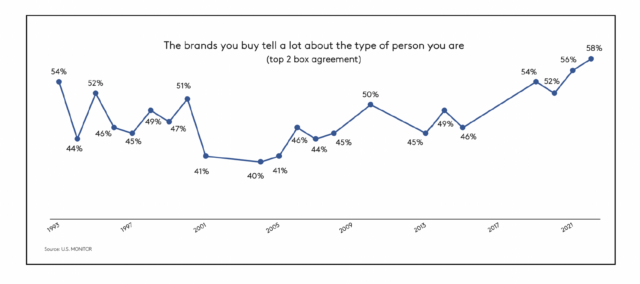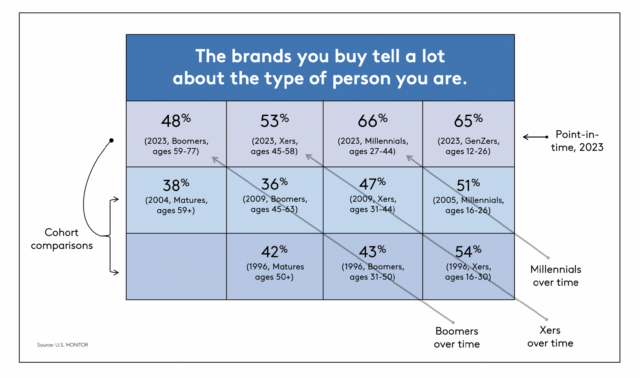Whether or not the function of manufacturers in individuals’s lives is for the higher or for the more severe is a long-running debate. Essentially the most influential anti-brand voice of current classic is journalist and social provocateur Naomi Klein, who shot to fame on the cusp of the brand new century along with her bestseller, No Emblem: Taking Purpose on the Model Bullies, through which she denounced world manufacturers for distorting markets, tradition, work and even consumerism itself.
A opposite place defending large enterprise on the whole, not simply manufacturers particularly, was articulated by George Mason College economist and widespread blogger Tyler Cowen in his 2019 e-book, Massive Enterprise: A Love Letter to an American Anti-Hero. Cowen argued that the virtues of massive enterprise are so deeply taken without any consideration that it may be laborious to convey them into clear focus, one in every of which is the elemental proven fact that manufacturers are the producers of the prosperity we take pleasure in and devour. (And as a enjoyable of entirety, within the ultimate footnotes to his final chapter, Cowen cited some social science he termed speculative that purports to indicate individuals behave higher after publicity to manufacturers like Apple and Disney.)
Professional or con, the idea working by way of this debate is that persons are intently linked to manufacturers, even perhaps figuring out with them. However this, too, is debatable, with many arguing that branding isn’t as central to purchasing as claimed or that branding works extra by catching the attention than by stirring the guts. So, the query of connection is necessary to look at. U.S. MONITOR gives some helpful perspective. The kind of individual that I’m. On and off since 1993, MONITOR has requested a query about settlement or disagreement with the assertion, “The manufacturers you purchase inform lots about the kind of individual you might be.” This can be a query about how a lot individuals really feel that manufacturers reveal their id. Settlement would possibly suggest that individuals select manufacturers to make a press release about themselves. However even when not an intentional sign, settlement no less than implies that manufacturers are a clue that others can depend on.
Clearly, this query isn’t a definitive or full measure of the roles that manufacturers play in individuals’s lives. However it’s a query worded to straight zero in on manufacturers in a strongly acknowledged manner. We all know from expertise that sturdy, direct questions present higher discrimination and insights by pushing individuals away from each yay-saying and hedging.
Right here’s what we see as now we have tracked this query over time:

An Elbow Up. Accurately decoding development traces will be difficult, and this one isn’t utterly easy. So, let me step by way of it. And don’t fear, what follows isn’t nerdy analysis discuss. As will be seen on this trendline, as a rule, the vast majority of shoppers have disagreed with this sturdy assertion about model id. Within the twenty-some years from 1993 to 2015, half or extra agreed solely 4 occasions. Often, it was lower than half, typically a lot much less.
Over this era, every of the highs was preceded (apart from the primary) and adopted by a lot decrease settlement, so it was a sample of random wobble round a flat line. There does appear to be a drop-off proper after the flip of the century, however quickly it returned to the earlier stage. It’s the final 4 years which have damaged the sample—it’s greater than half in every year, with the look of an upward development rising, although manner too quickly to inform. However even when settlement isn’t trending up, it’s nonetheless noticeably increased than earlier than.
That stated, we must always be mindful the precise ranges we see right here. Whereas the latest studying of 58 p.c is the very best ever, the 42 p.c who disagree is as excessive as the standard stage of settlement throughout that two-decade run from 1993 to 2015. There isn’t any consensus view on this query—not earlier than, not now. Manufacturers are self-expressive for a lot of, however removed from all, even with the current uptick. So, takeaways must be drawn with warning and no over-generalization.
The Product Period. The formative period of recent promoting was product-centric. The ‘Mad Males’ TV present was principally a historic fiction of the advert trade within the Sixties on the tail finish of that period (albeit with ingesting and womanizing amped up for dramatic impact). It revolved across the character of Don Draper, whose fashion and considering had been meant to epitomize the inventive philosophies of seminal mid-century advert figures. Like Albert Lasker (1880-1952), who invented the job of copywriter, and Rosser Reeves (1910-1984), who invented the USP or the concept of the distinctive promoting proposition. Lasker stated copywriters had one job—to write down in regards to the product. Reeves informed them what and easy methods to write about it. The product was king as the trendy client financial system took form throughout the tumultuous first half of the twentieth century. However the Sixties had been a couple of final journey on the Mad Males merry-go-round. This decade additionally ushered in a brand new mind-set about promoting.
The Period Of The Particular person. Within the aftermath of WW2, philosophers, writers, scientists, artists, musicians, historians, economists, and different public intellectuals, together with media theorists and administration consultants, all contributed to an intense, communal soul-searching and rethinking of society, tradition, politics, and enterprise. Broadly talking, there was a turning away from conventional establishments—together with every little thing from monarchies and colonial empires to political events, church, authorities, and enterprise. This unleashed an explosion of latest cultural types that celebrated individualism and self-expression. Promoting was caught up on this at least the rest.
Main emphasis on the product gave technique to a brand new emphasis on the person individual shopping for the product, essentially the most well-known instance of which was the Pepsi Era marketing campaign that debuted in 1963 and helped kick off the promoting Artistic Revolution that’s no much less influential in the present day. The individuals who purchased a product had been the promoting level of a model. Shopping for it could sign to different individuals that you’re that sort of individual. Not a model as one of the best product, however a model as one of the best ways to signify oneself to others.
So, how has this performed out, then and now, when it comes to expectations about manufacturers? How a lot of this do shoppers need from manufacturers? Model as self, kind of. Boomers grew up throughout the Sixties and Seventies interval of newly permissive self-expression, and thus, we’d anticipate to see a long-lasting affect on their attitudes about manufacturers as a way of self-expression.
We are able to have a look at them in distinction to different generations within the desk beneath.
Apologies for this busy desk, but it surely’s essentially the most environment friendly technique to present the three related comparisons: Level-in-time. Over time. Cohorts.
The purpose-in-time comparisons throughout the highest row present Boomers lowest, the youthful cohorts highest, and Xers in-between. It seems to be like one thing to do with being younger, however that doesn’t reply our query about Boomers, and it raises extra questions in regards to the different cohorts.
We have to dig deeper. Which implies I’m going to must geek out for just a few brief paragraphs. Hold tight. This gained’t damage for lengthy. Have a look at the diagonals, which present every cohort over time. If there’s a youth impact, we must always see increased settlement inside every cohort at youthful ages. However there isn’t any change, apart from Millennials, and that bump is within the mistaken course for a youth impact.
It’s extra nuanced, although. Boomers and Xers did go down barely (diagonally, row two vs. row three), then, like Millennials, jumped up a bit (diagonally, row one vs. row two). Some societal issue is perhaps the rationale for this current enhance in settlement, but it surely affected all cohorts equally, not in a different way, in accordance with age. This raises the chance that the point-in-time variations are cohort results arising from generational beginning factors. To evaluate this, have a look at the columns stacking up cohorts at (roughly) the identical ages. Scan them each up and down and sideways.
Admittedly, this can be a lot of comparisons to absorb abruptly. However the total sample is what’s necessary. Sideways, at all ages and in each comparability, Boomers are usually decrease, Xers barely increased, Millennials increased nonetheless, and Gen Zers highest of all. These are cohort results—persistent, constant variations amongst cohorts. Up and down, the cohort results solely pop lately, suggesting an amplifying issue that impacts everybody, but to completely different levels throughout the cohorts.
That’s it for the info torture. My hidden agenda was to indicate how I feel by way of knowledge. Extra importantly, three takeaways.
1. Manufacturers are on the recent seat. It’s not simply politics which have manufacturers below the microscope. We’re in an period of extra demanding shoppers—as my colleague Don Abraham places it, confrontational consumerism. That is the societal amplifying issue I discussed. All people expects extra of manufacturers than ever earlier than. Plus, in a time when different establishments have misplaced floor, a much bigger function is predicted of manufacturers, particularly for the generations coming of age throughout this time. With extra of their expectations invested in manufacturers, youthful individuals need manufacturers to be higher representations of themselves. Not as trend; fairly, as statements of id and values. In no small manner, that is politics, each left and proper, by way of a facet door. There’s no youth impact, however there may be an impact on youth in the present day that was not so for Boomers of their youth. It’s two-thirds of tomorrow’s shoppers, a stage of settlement unlikely to decrease as they become old, if the info tabled listed here are any information.
2. Change occurs on a protracted trajectory. The worth shifts from over half a century in the past are extra absolutely expressed in tomorrow’s era than within the era of Boomers who grew up throughout that point. What we see here’s a reminder that actually large modifications unfold generationally not simply contemporaneously, and sometimes with extra affect as time goes by.
3. Don’t neglect efficiency and high quality. Manufacturers should ship the answer(s) they’re constructed for. No matter manufacturers might ‘inform’ in regards to the varieties of people that purchase them, they have to work effectively. That might not be sufficient for a lot of, but it surely’s greater than sufficient for nearly as many others.
Contributed to Branding Technique Insider By: Walker Smith, Chief Data Officer, Model & Advertising and marketing at Kantar
At The Blake Mission, we assist purchasers from all over the world, in all phases of growth, outline and articulate what makes them aggressive and worthwhile. We assist speed up development by way of technique workshops and prolonged engagements. Please e mail us to learn the way we may help you compete in a different way.
Branding Technique Insider is a service of The Blake Mission: A strategic model consultancy specializing in Model Analysis, Model Technique, Model Development and Model Training
FREE Publications And Assets For Entrepreneurs
Publish Views: 20

